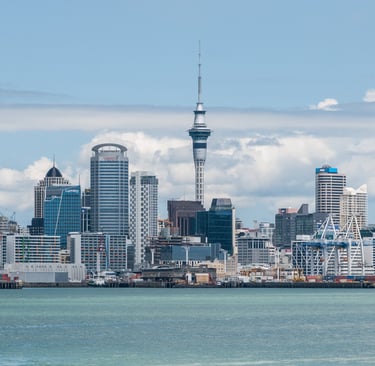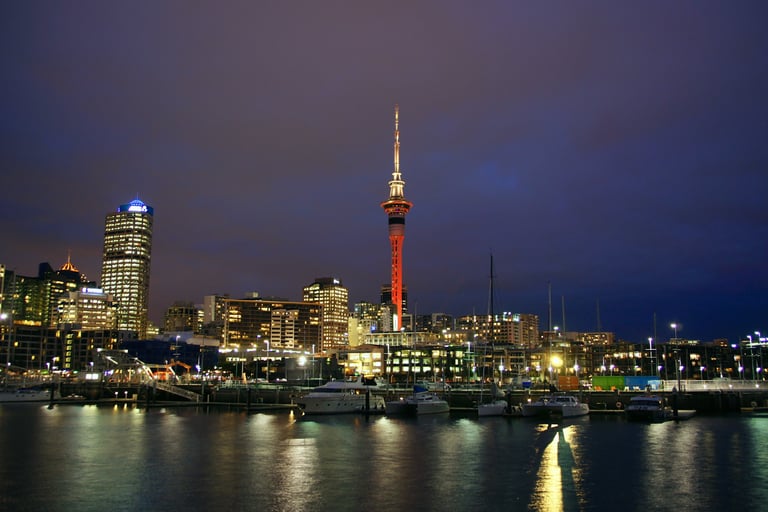Auckland – Where the Seas Begin
Explore Auckland, a city where ocean horizons meet volcanic earth—New Zealand’s gateway to adventure, culture, and coastal beauty
DESTINATIONS
Jetsclusive
6/27/20255 min read


Auckland – Where the Seas Begin
Auckland isn’t just a city. It’s a doorway, a meeting place, and a heartbeat where New Zealand meets the sea. Known as Tāmaki Makaurau to Māori, Auckland rises on a stretch of land squeezed between the Pacific Ocean and the Tasman Sea. Water shapes everything here: the sparkling harbors, the sailboats that fill the horizon every weekend, and the city’s spirit of openness and adventure. Home to over 1.5 million people and more than 50 volcanoes, Auckland stands as both New Zealand’s natural gate and its largest urban center. Its wharves, parks, and beaches hold stories of journeys, trade, and belonging—a mosaic built where the seas begin.
Auckland’s Geography: Where the Land Meets the Sea
Auckland’s location is like nowhere else in the world. The city sits on a slim isthmus, just a few kilometers wide at its narrowest point, with water on nearly every side. To the north lies the Waitematā Harbour, opening into the Hauraki Gulf and the Pacific Ocean. To the south lies Manukau Harbour, reaching toward the Tasman Sea. This spiny backbone of land hosts a landscape born from fire and shaped by tides.
The volcanic field here includes over 50 cones and craters, with Rangitoto Island looming off the coast as Auckland’s youngest and largest volcano—just 600 years old. These ancient eruptions didn’t just mold the land; they fostered rich soils that support lush native forests and rare creatures. The proximity to two harbors creates a climate that’s mild and humid, feeding a huge range of plants and animals. Rainforests on the city’s fringes give way to rolling suburbs, yet even city neighborhoods hide subtropical gardens and birdlife in plain sight.
The Dual Harbors: Waitematā and Manukau
Auckland’s twin harbors give it a split personality. The Waitematā Harbour to the north sparkles with yacht masts and container ships, serving as the gateway for arrivals by sea. This deep natural harbor was once a key site for Māori waka (canoe) travel and trade. With colonization, it became the port for European settlers and remains the city’s economic and cultural front door. Key landmarks like the Auckland Harbour Bridge and Princes Wharf animate its shoreline.
Manukau Harbour to the south feels wilder and less tamed. Its entrance, known for tricky tides and shifting sands, made it less appealing for large-scale shipping—yet Māori villages thrived on its fish, shellfish, and strategic sheltered waters for centuries. Today, Manukau feeds the city’s food scene and offers quiet getaways in contrast to the busier north. These two harbors define the way Aucklanders relate to the water, each inviting different rhythms and experiences.
Compare Private Jet Pricing To Auckland Here Powered by Villiers Jets — Trusted by 1,000+ flyers worldwide
Volcanic Origins and Coastal Ecosystems
Auckland rises from fire and water. The city’s volcanic cones—like Maungawhau (Mount Eden) and Maungakiekie (One Tree Hill)—shape neighborhoods, provide panoramic lookouts, and preserve significant Māori archaeological sites. Rangitoto Island stands as both a landmark and a home to unique forests, with lava fields sheltering species found nowhere else.
Out in the sparkling Hauraki Gulf, more than 25 islands cluster close to the city. Waiheke offers vineyards and white-sand beaches, while Tiritiri Matangi serves as a sanctuary for threatened wildlife such as kiwi and takahe. The Gulf’s waters are rich with fish, dolphins, and, sometimes, visiting whales. Regional parks hug the city’s edges, protecting kauri forests, waterfalls, and estuaries. Auckland’s wild west coast, with its black-sand surf beaches like Piha and Muriwai, rounds out the picture—a seaside playground ringed by natural drama.
The City of Sails: Maritime Culture and Economy
Auckland’s nickname, “The City of Sails,” isn’t just for show. At any time, the harbors fill with sailboats of all shapes, from racing yachts to sturdy fishing vessels. The port moves millions of tonnes of goods a year, but Auckland’s maritime culture runs deeper. Kiwis love the water—swimming at Mission Bay, windsurfing off Takapuna, or competing in world-class events like the America’s Cup.
Sailing isn’t just a pastime; it’s an identity. Many Aucklanders grow up learning to handle boats, read tides, and respect the sea’s moods. Yachting clubs are social hubs, while fishing from wharves or the rocky west coast is a family tradition. The ocean shapes daily life, work, and play, keeping Auckland closely tied to the tides.
Cultural, Historical, and Social Significance of Auckland’s Coastlines
Water doesn’t just touch Auckland’s shores. It flows through the city’s story, shaping its people, art, and sense of place. Auckland stands as New Zealand’s gateway, home to the country’s most diverse urban population and a living link to ancient Māori traditions.
Compare Private Jet Pricing To Auckland Here Powered by Villiers Jets — Trusted by 1,000+ flyers worldwide
Māori Settlement and Coastal Traditions
Long before European explorers arrived, Māori iwi (tribes) built thriving villages along Auckland’s bays and volcanic slopes. The sea was a highway, full of fish and shellfish, and vital for trade. Key pā (fortified villages) such as those on Maungakiekie and Maungawhau overlooked wide water views, chosen for defense and food.
The sea remains sacred in Māori culture, woven into language, ceremony, and daily life. Many contemporary Māori still fish, gather shellfish, and share stories that honor ancestral ties to the coast. Rituals like waka journeys and kapa haka performances celebrate this connection, while the protection of sacred sites and the revival of traditional navigation show the sea’s enduring meaning.
Port City to Modern Metropolis: A Historical Overview
Auckland’s fate as a city has always swayed with the tides. The site became the colonial capital in 1841, chosen for its strategic location between two harbors. Early European settlers built wharves, churches, and neighborhoods along the waterfront, shaping Auckland’s first growth spurt.
As railways and roads spread outward, the city pulled in migrants from around New Zealand and overseas—including Pacific Islanders, Asians, and Europeans. The port drove industry and brought prosperity, while grand volcanic parks, town halls, and the Sky Tower show this rise. Today, Auckland balances history and ambition, blending sturdy Victorian houses with high-rises, and weaving local heritage into a cosmopolitan outlook.
Coastal Diversity: Arts, Festivals, and Everyday Life
Auckland’s beaches, parks, and harbors spark creativity in everyday moments. Every year, festivals like Pasifika and Auckland Anniversary Day fill the waterfront with music, food stalls, and canoes. The Auckland Art Gallery, perched near the central city, showcases local artists who draw inspiration from coastal landscapes and cultural diversity.
Weekends bring families to Long Bay and Cornwall Park for picnics and kite-flying. Walkers traverse the cliffs at North Head or spot seabirds on the rugged west coast. Surfing, dragon boating, and outrigger canoe races turn the water into a stage and the city’s many cultures into a mosaic of traditions. Auckland’s coastlines are more than scenery—they’re a stage for shared stories, play, and celebration.
Conclusion
Auckland truly is “Where the Seas Begin.” The city’s twin harbors, volcanic hills, and wild coastlines set the stage for a life shaped by water and marked by diversity. Here, Māori legacy meets global cultures, and city bustle blends with native forests, windswept beaches, and quiet islands.
Auckland’s draw isn’t just its natural beauty—it’s the way daily life moves with the tides and the seasons. As Auckland grows, embracing sustainability and inclusion, its identity as a maritime city stays strong. This gateway between land and sea offers adventure, belonging, and a sense of endless possibility. If you ever wondered where the journey begins, start where the seas do—in Auckland.


Luxury
Explore the world of private aviation and travel.
support@jetsclusive.net
© 2025. All rights reserved.
